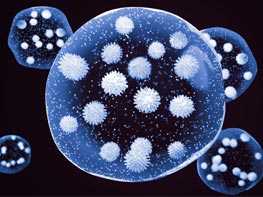
Health protection in the workplace

Autor:
Andrej Arnold
Condair GmbH
Andrej Arnold
Condair GmbH
As the relative humidity of the air increases, suspended particles become larger and heavier. They move more slowly and settle more quickly to the ground, which in turn helps to minimize the spread of viruses, bacteria and allergens.
Indoor spaces have an especially large number of these particles enclosed in water. They contain dust, viruses, bacteria and allergens. When the air is dry, these particles shrink, becoming lighter and more mobile, and can spread germs over much longer distances.
Air humidification in winter:
Keeping your employees healthy
Air humidification: The fight against dry heating air
Outside, it's snowing, while inside, heating and ventilation systems are running at full blast. This leads to decreased humidity in the office, and the air your employees are breathing dries out extremely quickly. This endangers workers' health: Your employees feel tired, have difficulty concentrating, and complain of sore throats and burning eyes. Infections can then arise, leading to coughing, runny nose, bronchitis and sinus in¬flam¬mation as the next stage of illness. Dry heating air is one of the main causes of the annual wave of colds and flu.
Studies have shown a connection between recurring respiratory illnesses in winter and poor indoor air quality. The explanation is as follows: As dust, dirt and germs accumulate on the sticky layer of mucus in the nose, tiny hairs known as cilia serve to move them along towards the throat, where they can be coughed out or swallowed. For this to work, however, the air being breathed in must be sufficiently humid. Dry air draws water out of the mucous membranes and dries them out.
The loss of mois¬ture shrinks the surface supporting the cilia, causing it to become thinner, and the flattened-down cilia can no longer move freely back and forth. The mucus layer therefore stops moving, and germs have plenty of time to make their way into neighboring cells and trigger an infection. (See illustration)
Effects of humidity
Air consists of a mix of gases, suspended particles and water vapor. Most of the suspended particles are impurities that are harmful to human health. Indoors, most of these particles tend to settle onto surfaces like desks, shelves and windowsills, where they blend with the "usual" dust. Employee activity (walking around, opening and closing doors etc.) and ventilation stir the dust up again, at which point it may be inhaled.
Dust is stirred up much more easily when the air in the room is dry, as any housewife can tell you. The dust, and the harmful substances and disease-causing pathogens mixed into it, also stay suspended in the air much longer when the air is dry, so that employees inevitably end up inhaling it.
Proper air humidification reduces the amount of harmful particles in the air that employees are breathing, and leads to better air quality. Water binds the aerosols together so that they become heavier, sink more quickly to the ground, and cling more readily to surfaces. This keeps them out of the air, and your employees can breathe freely again.
A comfortable environment for your employees
The ideal humidity for an indoor environment is between 40 and 60 percent. People feel most comfortable in this range, and disease-causing pathogens and air pollution are reduced to a minimum. To keep indoor air humid even when the heating is on, there are essentially two types of air humidifiers:
Which process is best for your humidification needs depends on building codes and technical safety requirements. You must also make sure that the system fits with the specifics of your office's construction. The best approach is to seek professional advice before deciding to purchase an air humidification system.
Technical article: Air humidification in winter: Keeping your employees healthy — by Andrej Arnold, Dipl. Ing. (FH), Condair GmbH, Germany, South Regional Center

